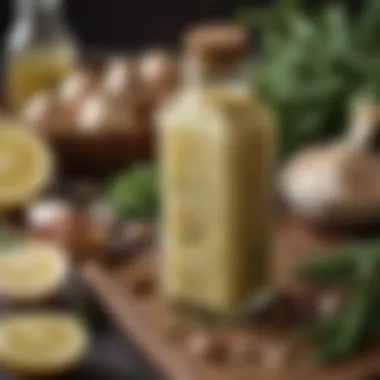Garlic Lemon Dressing: Elevate Your Culinary Experience


Intro
Garlic lemon dressing is a delightful combination that amplifies flavors in culinary applications. It is both simple and sophisticated, making it suitable for countless meals. Busy individuals often seek quick yet flavor-packed recipes that enhance their dining experience without complicating the cooking process. This dressing serves as a guide to achieving that perfect harmony between taste and ease.
In this article, we will explore the essential aspects of garlic lemon dressing. We will delve into its ingredient list, step-by-step preparation methods, nutritional insight, and imaginative usage. You will also discover variations and options for storing this versatile dressing. By the end of this guide, you may realize that this dressing is not just a simple recipe—it is an essential addition to your culinary repertoire.
Recipe Overview
Zesty Garlic Lemon Dressing
Yield: 4 servings
Prep Time: 10 minutes
Difficulty: Easy
Main Ingredients:
- Fresh garlic
- Fresh lemon juice
- Olive oil
- Fresh herbs (like parsley or basil)
- Salt and pepper
Garlic lemon dressing is characterized by its refreshing acidity and pungent garlic flavor. This balance enhances not just salads, but also grilled meats, roasted vegetables, and grain dishes.
Step-by-Step Instructions
To begin, gather your ingredients on a clean work surface. Here's how to prepare the dressing:
- Prep the garlic: Start by peeling and finely mincing three cloves of fresh garlic. If a milder flavor is preferred, reduce the amount.
- Juice the lemons: Squeeze juice from two large lemons until you have roughly a quarter cup of lemon juice.
- Combine ingredients: In a mixing bowl, combine the minced garlic, lemon juice, and half a cup of olive oil.
- Seasoning: Add a teaspoon of salt and freshly cracked pepper to your taste. Use a whisk to blend everything together until thoroughly mixed.
- Add herbs: Optional, but recommended, finely chop two tablespoons of fresh herbs and mix them in for extra flavor.
- Taste test: Adjust your seasoning if needed.
Time-saving strategies:
- To mince garlic quickly, consider using a garlic press.
- Leverage a blender or food processor for all mixing, though whisking by hand retains more texture.
- If fresh herbs are unavailable, use a teaspoon of dried herbs instead.
Nutritional Information
Each serving of garlic lemon dressing contains approximately:
- Calories: 120 kcal
- Protein: 0.5 g
- Total Fat: 13 g
- Carbohydrates: 1 g
- Sugars: 0 g
- Saturated Fat: 2 g
- Dietary Fiber: 0 g
This dressing is low in carbohydrates and high in heart-healthy fats sourced from olive oil. It provides essential nutrients, including vitamin C from lemons and antioxidants from garlic.
Quick Cooking Tips
- Consider using an immersion blender for a smoother texture.
- Manage time effectively by allowing the dressing to infuse flavors while you prepare the rest of your meal.
- Replace fresh herbs with dried spices like garlic powder if pizzazz is unavailable.
Related Recipes & Variations
You can also explore various ways to use garlic lemon dressing:
- Salad Variants: Use a blend of arugula and spinach for a unique salad base.
- Protein pairings: It complements both grilled chicken and fish exceptionally well.
- Vegan option: Substitute animal proteins with chickpeas or tofu for a plant-powered meal.|
Feel free to share your own twists on this dressing. Innovation leads to new doors in gastronomy, exactly where exciting cuisines often begin.
Prelims to Garlic Lemon Dressing
The significance of garlic lemon dressing in the culinary world is not only about its basic components but also about the depth it brings to various dishes. This dressing offers a simple yet effective way to enhance flavors, making it a staple in many kitchens.
Nourishment is a key benefit. Garlic, lemon juice, and olive oil each contribute essential nutrients. These include vitamins, minerals, and antioxidants that can support overall health. Garlic is known for its immune-boosting properties, while lemons provide vitamin C, a powerful antioxidant. Olive oil is revered for healthy fats that can promote heart health.
Beyond health advantages, using garlic lemon dressing is about convenience. In today’s fast-paced environments, many individuals search for quick and delicious options to complement their meals. This dressing can be prepared with minimal effort and accommodates a wide range of preferences. It’s suitable for a variety of diets, including vegetarian and gluten-free.


Another essential consideration is the versatility of this dressing. It fits seamlessly into numerous culinary applications, whether drizzled over fresh salads, used in marinades for proteins, or poured over roasted vegetables. By providing this serving flexibility, garlic lemon dressing appeals to serious culinary enthusiasts who wish to explore different flavor profiles in their meals.
Nutritional Profile
The Nutritional Profile of garlic lemon dressing is essential for understanding its value in contributing to a healthier diet. The ingredients used in this dressing bring various vitamins, minerals, and other beneficial components that not only enhance the flavor but also promote well-being. Knowing these nutritional elements can help decide how to incorporate the dressing effectively into different meals.
Vitamins and Minerals
Garlic lemon dressing contains several key vitamins and minerals essential to overall health. Here's a breakdown of some of the valuable nutrients found:
- Vitamin C: Found predominantly in lemons, this vitamin acts as a potent antioxidant. It protects cells from damage and helps strengthen the immune system, aiding in the body's defense against illnesses.
- Vitamin B6: Garlic contains this vitamin, essential for brain development and function. Studies show Vitamin B6 can help improve mood and reduce symptoms of depression.
- Manganese: Present in garlic and olive oil, it plays a critical role in bone formation and the metabolism of carbohydrates and fats. Manganese has antioxidant properties as well, which can help.
- Thiamine (B1): This vitamin is important for energy metabolism and increasing cognitive function. It’s vital for maintaining health at a cellular level.
- Copper: A mineral found in garlic, that aids in iron absorption and contributes to nerve and immune function.
These vitamins and minerals combine to make garlic lemon dressing a powerhouse addition to salads and marinades, enhancing nutritional value and taste.
Health Benefits
Integrating garlic lemon dressing into meals supplies a range of health benefits. Looking at its individual ingredients helps understand its positive impact on health:
- Improves Digestion: Garlic as a component can enhance gut health by promoting the growth of good bacteria while keeping harmful bacteria at bay.
- Supports Heart Health: Olive oil and garlic work together to reduce high blood pressure and lower cholesterol levels, contributing significantly to cardiovascular health.
- Boosts Immunity: The combination of Vitamin C from lemons, along with other nutrients in the dressing provides a solid boost to the immune system.
- Weight Management: Low in calories and high in flavor, it can replace heavier dressings, assisting those who track caloric intake or are looking to manage their weight more effectively.
- Enhances Mood: The nutritional components in garlic can help elevate one’s mood and potentially reduce stress, making it beneficial not just for the body but also for mental wellness.
This dressing provides significant health benefits while appealing to diverse taste buds. Understanding its nutritional profile can aid in smart meal planning.
In summary, garlic lemon dressing presents numerous nutritional advantages given its strength in vitamins and minerals. Consciously utilizing this dressing in meals not only amplifies flavor but also contributes to improved health outcomes.
Core Ingredients
The success of garlic lemon dressing lies in its core ingredients. The right choice of components not only influences flavor but also impacts nutritional value. Understanding each ingredient is essential, whether for maximizing health or enhancing a dish’s profile. Garlic, lemons, and olive oil come together to create a harmonious blend that can elevate various culinary experiences.
Garlic: Types and Benefits
Garlic serves as the heart of the dressing, bringing a depth of flavor and numerous health advantages. There are various types of garlic available. Some common ones include softneck, hardneck, and elephant garlic. Each type has its unique flavor and culinary applications.
Softneck garlic is the most common in supermarkets and lends a mild taste. This variety is ideal for making raw dressings as it offers a robust flavor without being overpowering. In contrast, hardneck garlic has a stronger taste, making it preferable for cooked dishes or those needing gourmet flair. Elephant garlic, while not technically garlic, has a mild flavor that is delicious roasted.
In terms of benefits, garlic is known for its ability to enhance the immune system. It contains allicin, a compound recognized for its antibacterial properties. Including garlic in your diet can also help lower blood pressure and cholesterol levels, ultimately supporting cardiovascular health.
Lemon: Varieties and Uses
Lemon adds acidity and brightness to the dressing. The most commonly used lemon is the Eureka variety, known for its juicy pulp and tart flavor. Other options include the Meyer lemon, which has a sweeter taste, and the Lisbon lemon, recognized for its zesty kick.
Choosing the right lemon can make a significant difference in the final flavor of the dressing. For bright and acidic profiles, Eureka and Lisbon are favorable. However, if a milder sweetness is desired, Meyer lemons can provide that softer touch. Besides their flavor, lemons are rich in vitamin C and antioxidants, making them excellent for bolstering the immune system and enhancing skin health.
Olive Oil: Selection and Quality
The choice of olive oil also plays a crucial role in the dressing, as it serves as a base that binds the flavors. When selecting olive oil, it is vital to consider quality. Extra virgin olive oil stands out for its rich flavor and health benefits. Ensure that it is cold-pressed, as this method preserves the oil's natural antioxidants.
Look for labels that confirm the oil’s purity and origin. Taste can vary widely from regions such as Tuscany, Greece, or California. Different oils express distinct notes—from lush herbaceous to subtle fruity ones. A good quality olive oil enhances the garlic and lemon, complementing rather than overpowering other flavors in the dish.
In summary, understanding the core ingredients of garlic lemon dressing enables cooks to harness their unique benefits. Using high-quality garlic, lemons, and olive oil not only refines flavors but also provides numerous health advantages, moving beyond mere culinary delight.
Preparation Techniques
Preparation techniques play a pivotal role in crafting the ideal garlic lemon dressing. Each step contributes to the overall flavor and texture of the dressing. Those who understand these methods can optimize the taste and enhance the characteristics of the ingredients they work with. By mastering these techniques, an individual can ensure their dressing is consistent and enjoyable.
Chopping Garlic
Chopping garlic needs to be approached with precision. When freshly chopped, garlic releases sulfur compounds, known for building its intense flavor. The method used can affect the degree of this release. For instance, mincing will yield a stronger garlic taste, while slicing results in a milder note. To chop garlic efficiently, follow these steps:


- Start by separating cloves from the head.
- Remove the outer skin of each clove. A gentle tap of the knife can aid this.
- Place the clove flat on a cutting board and use the knife blade to crush it slightly. This action helps to release oils.
- Once crushed, chop evenly to your desired fineness.
Chopping garlic correctly not only amplifies its flavor but also helps it meld seamlessly with other ingredients in the dressing.
Juicing Lemons
Juicing lemons is simple but demands attention to technique to extract maximum juice without the bitterness of the pith. The quality of the lemon used positively influences the taste of the dressing. Follow these simple steps to juice a lemon effectively:
- Roll the lemon on a hard surface to soften it. This increases juice yield.
- Cut the lemon in half.
- Use a citrus juicer or your hands to press and twist, extracting the juice.
To avoid the seeds, consider using a sieve when pouring juice into your mixing bowl. The brightness from freshly squeezed lemon elevates the dressing, making it more vibrant and palatable.
Mixing Ingredients
Mixing the ingredients should be done in a manner that ensures even distribution. This process is where flavors come together. Following these steps ensures a good mix:
- Start with the garlic and lemon juice in a bowl. Stir before adding the olive oil gradually.
- While stirring, slowly drizzle in the olive oil. This emulsifies the mixture, creating a smoother consistency.
- Adjust ratios according to personal preference.
Finding the right balance of garlic and lemon will define your dressing’s character, while the olive oil will bring everything together. The mixing technique also affects the texture. As you hone these preparation techniques, your garlic lemon dressing will appeal more to your palate.
Recipe Variations
Exploring recipe variations allows you to personalize garlic lemon dressing, making it align with varied taste preferences and dietary needs. By experimenting with different ingredients and flavors, you can transform a basic dressing into something that complements numerous dishes. Each variation brings unique elements, enhancing flavor profiles while offering diverse health benefits. Understanding these variations is key for busy individuals seeking new ways to enjoy garlic lemon dressing.
Herb-Infused Dressing
An herb-infused dressing integrates fresh herbs like parsley, basil, or cilantro into the classic garlic lemon formula. This addition not only boosts its flavor but also enriches its nutritional components. Fresh herbs can provide additional vitamins and antioxidants, supporting overall health.
To create this variation, simply chop your choice of herbs finely and mix them with the base ingredients of garlic, lemon juice, and olive oil. The proportion may adjust based on your taste preference; you may prefer more herbs for a robust taste, or a subtle amount for a gentle layer of flavor.
Pair this dressing well with grain-based salads or vegetable medleys to enhance freshness. It serves well as a final drizzle to elevate the visual aspect of the dish as well as its taste.
Spicy Garlic Lemon Dressing
For those who crave heat, spicy garlic lemon dressing adds a kick of heat to the original formula. Incorporating ingredients such as red pepper flakes, fresh jalapeños, or a dash of sriracha yields a zesty experience. This fiery twist elevates not only the flavor but also makes the dish exciting and memorable.
To craft this, blend your basic dressing components with the chosen spicy element, adjusting the heat according to tolerance. The resulting dressing is excellent for grilled meats or spicy vegetable dishes. The spicy notes help brighten richer flavors, making it a versatile choice for various cuisines.
Creamy Garlic Lemon Dressing
A creamy variant pairs the zest of lemon and pungency of garlic with creaminess, often achieved by using Greek yogurt, sour cream or mayonnaise. This dressing brings a rich texture alongside the refreshing acidity from the lemon. Not only does the creaminess offer a different mouthfeel, but it also can make the dressing slightly more substantial.
Mix the chosen creamy ingredient with the base ingredients, and consider checking for the required balance of acidity and richness. This creamy dressing can complement salads that have robust elements, making each bite satisfying and indulgent. Grains, roasted meats, or as a dipping sauce could also benefit from this rich dressing.
Serving Suggestions
Understanding the ways to utilize garlic lemon dressing can elevate various meals, providing depth and flavor. This section showcases the versatility garlic lemon dressing offers in culinary applications. Use it to enhance salads, vegetables, and proteins. Each suggestion illuminates how the dressing complements diverse dishes, spotlighting not only taste but also nutritional benefits. Labels such as light or refreshing apply well, offering quick serving choices that suit a range of eating occasions.
Salads
Salads come to life with garlic lemon dressing. The acidic brightness of lemon balances the richness of oils and fats often found in salad mixtures. Combining diverse elements like greens, vegetables, and proteins creates a layered taste experience. For a robust option, try mixed greens topped with fresh herbs, cherry tomatoes, and avocado drizzled with this special dressing. Consider adding nuts or seeds for texture, and you’ll enhance both taste and nutritional value. This dressing also works well to dress grain-based salads such as quinoa or farro, making them heartier.
Grilled Vegetables
Garlic lemon dressing is an excellent companion for grilled vegetables. It not only acts as a marinade before grilling but also functions as a finishing touch. When mixed with zucchini, bell peppers, and eggplant, the dressing elevates the natural sweetness of grilled veggies. The heat facilitates the melding of flavors, making each bite taste more vibrant. Using this dressing post-grilling retains its bright flavor while providing a glossy sheen that makes the dish visually appealing. Care should be taken to lightly coat the vegetables to avoid overpowering their inherent tastes.
Marinades for Proteins


Marinating proteins in garlic lemon dressing can be a game changer for kitchen endeavors. Chicken, fish, pork or tofu absorbs these flavors at a molecular level when given adequate time. The acid from the lemon tenderizes the proteins while enhancing their taste. For chicken, combining the dressing with herbs like rosemary or thyme can create a gourmet feel, while fish benefits from its lighter citrus notes. This technique not only ensures juicier outcomes but can also be a time saver; prepare your proteins in advance for an efficient kitchen experience.
Integrating garlic lemon dressing into various meals not only improves taste but also encourages healthy eating patterns. Each suggestion outlined adds seamless flavor while being practical for busy lives.
Storage and Shelf Life
Understanding how to properly store garlic lemon dressing can enhance both its longevity and quality. Like many dressings, this one has a specific shelf life that can vary depending on how well it is handled and stored. Preserving the freshness of your dressing not only retains its flavor but also ensures the nutrients are intact when you decide to use it.
It's crucial to consider factors that affect the lifespan of the dressing. Ingredients like garlic and lemon juice are potent flavors, but they also contribute to the overall stability and quality. Once mixed, the dressing can become susceptible to spoilage if not treated with care. Proper storage ensures that it remains safe to consume while continuing to elevate your meals with its aromatic notes.
Refrigeration Guidelines
When it comes to storing garlic lemon dressing, refrigeration is the most recommended method. This keeps the ingredients fresh. After you have prepared the dressing, transfer it into a tightly sealed jar or container. Ensure that it is made of glass or food-safe plastic. Any air pockets should be minimized.
Store the dresssing in the refrigerator immediately. Cold storage can prolong the dressings potential shelf life significantly. Generally, homemade garlic lemon dressing can last for about 1 to 2 weeks when refrigerated.
It's important to check it for fitness before use. If you notice any unusual odor or separation, that can indicate spoilage. Before using, make sure to give it a good shake to recombine any separated ingredients.
Freezing Options
If you find yourself making a larger batch or simply want to keep your garlic lemon dressing for a longer period, freezing can be an option worth considering. Before freezing, blend the dressing as usual.
You can occupy an ice-cube tray for individual portions. This is particularly convenient as it allows you to thaw only the amount you need. Transfer the tray to the freezer. Once the dressing cubes are completely frozen, pop them out and place them into a resealable freezer bag. This method can help extend the dressing's shelf life well beyond the standard period when stored in the refrigerator.
Garlic lemon dressing can be usually frozen for 3 to 6 months in a consistent freezing environment. When you are ready to use some, take out a cube or two and allow them to thaw in the refrigerator overnight or at room temperature as needed.
Maintaining appropriate storage conditions for garlic lemon dressing not only preserves its freshness but substantially enhances the culinary quality of myriad dishes.
Common Mistakes
When it comes to preparing garlic lemon dressing, small errors can lead to significant differences in taste and health benefits. Recognizing common mistakes not only helps in crafting a perfect dressing but also ensures that the nutritional elements are fully optimized. Culinary enthusiasts often overlook these simple missteps. This section highlights two key mistakes that can impact the quality of your dressing and ultimately, your dining experience.
Over-Seasoning
Over-seasoning is a frequent issue when making garlic lemon dressing. With punchy flavors from garlic and the brightness of lemon, it is tempting to add more than needed. A little salt can elevate the taste, but too much can overpower the freshness. Here are some crucial points to consider:
- Balance Flavor: Introduce other ingredients gradually to achieve a harmonious blend.
- Taste Early and Often: After each ingredient addition, sample the dressing. This allows you to adjust as per your flavor preference.
"Adjusting seasonings in stages ensures a balanced and pleasing flavor profile."
- Remember Ingredients' Profiles: Garlic compounds can intensify when minced or crushed. Be cautious to keep a balance with lemon and salt.
By practicing restraint and continually tasting your mixture, you reduce the risk of over-seasoning, leading to a dressing that enhances rather than distracts.
Using Poor Quality Ingredients
The importance of ingredient quality cannot be overstated. In the realm of garlic lemon dressing, subpar components often diminish your efforts. Incorporating poor quality geekings not only compromises the taste but reduces nutritional value as well. To prevent this, consider the following:
- Choose Fresh Garlic: Use knobs of garlic that are firm and free from blemishes, as fresh garlic contributes a punchy and vibrant flavor.
- Opt for Fresh Lemons: Freshly squeezed lemon juice surpasses bottled options in both taste and additional nutrients. Excess chemicals can alter the dressing’s final profile.
- Select High-Quality Olive Oil: A good quality olive oil provides richness in flavor and plays a role on health benefits. Buying extra virgin is usually a safe choice.
Paying attention to the ingredients you choose is vital for the readiness of garlic lemon dressing. Focusing on high quality ensures a vibrant and health-centric choice for your dishes.
End
In summation, this article has unveiled the multifaceted world of garlic lemon dressing. The significance of this dressing lies in its ability to transform ordinary meals into extraordinary dishes with minimal effort. Highlighting essential ingredients, we recognize the potency of garlic in imparting flavor favorable health outcomes, alongside the zesty brightness of lemon, which enhances not only taste but appearance as well.
Key benefits of incorporating garlic lemon dressing into meals include:
- Flavor enhancement: Simple applications can turn a dull dish lively.
- Nutritional boost: The dressing offers a combination of vitamins and minerals that are particularly beneficial.
- Versatility: Its ability to pair excellently with diverse food, from salads to proteins, makes it valuable.
The practical aspects discussed throughout, such as ease of preparation, variations, and storage options, suggest that this dressing can offer value to any home cook, regardless of experience level. Understanding common pitfalls, like over-seasoning and using inferior ingredients, also enables an improved outcome for those trying their hands at this dressing, reducing frustration.
Garlic lemon dressing is more than just uh recipe; it is a culinary tool that encourages experimentation and creativity within the kitchen.
Ultimately, the insights shared in this guide make plain that garlic lemon dressing enriches our cooking repertoire. By appreciating both its ingredients and what it brings to the table, culinary enthusiasts can enhance not just everyday meals but can also heighten their gastronomic experiences.







